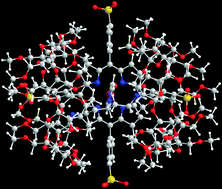Supramolecular dioxygen receptors composed of an anionic water-soluble porphinatoiron(ii) and cyclodextrin dimers†
Abstract
Three types of per-O-methylated β-cyclodextrin dimers, Im2CD, Im3NHCD and Py3NHCD, were prepared as globin models. Im2CD was synthesized by the condensation reaction of mono(2A-amino)-per-O-methylated β-cyclodextrin with 3-(1H-imidazol-1-yl)pentanedioic acid. Im3NHCD and Py3NHCD were obtained through the SN2 reactions of mono(2A,3A-epoxy)-per-O-methylated β-cyclodextrin with 3-(1H-imidazol-1-yl)pentane-1,5-diamine and 3,5-bis(aminomethyl)pyridine, respectively. These cyclodextrin dimers formed 1 : 1 supramolecular inclusion complexes of tetrakis(4-sulfonatophenyl)porphinatoiron(II) (FeIITPPS) in aqueous solution. The supramolecular complexes bound dioxygen (O2), with the O2 affinity of the FeIITPPS/Im3NHCD complex (P1/2O2 = 1.5 ± 0.1 Torr) being much higher than those of the FeIITPPS/Im2CD (36 ± 2 Torr) and FeIITPPS/Py3NHCD complexes (70 ± 5 Torr). On the basis of the results of the present study and previous results, it is concluded that the imidazole axial ligand at the linker attached at the 3- and 3′-positions of the cyclodextrin units causes higher O2 affinity as compared with the imidazole ligand at the 2- and 2′-positions and the pyridine ligand at the 2,2′- or 3,3′-positions. The electron donating ability and orientation of the axial ligand may control the O2 affinity of a supramolecular receptor.


 Please wait while we load your content...
Please wait while we load your content...